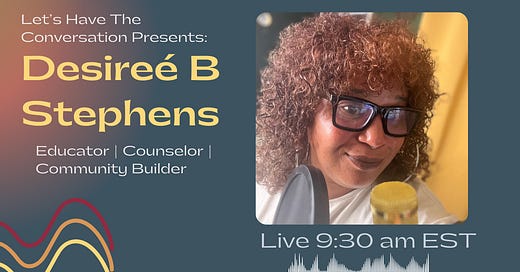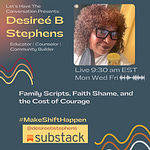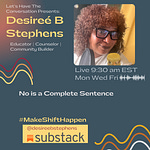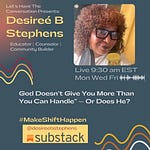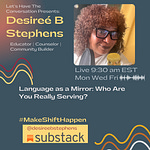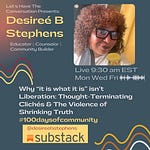First, let me say thank you.
Thank you for your patience with the burst of updates today. Thank you for the grace you’ve extended as I played catch-up. And thank you for letting me be human—sick days, tech issues, late uploads, and all.
This community? Y’all have shown up with so much care, and I don’t take it for granted. That’s what community looks like. Not perfection—but presence.
Some of y’all have been with me through my food poisoning recovery, tech chaos, deleted replays, and ADHD side quests—and still, you’re here. And that, to me, is what community looks like.
Not perfection. Not polish. But presence. You show up. You make room. You extend the very care I’m trying to model. And that means more than I can say. So AGAIN, thank you.
Let’s Talk About Healing After Harm
Here’s the truth that supremacy culture doesn’t prepare us for:
Harm is inevitable—but healing is a choice.
We are going to mess up.
We are going to cause harm—even when we mean well.
But if our relationships and communities are going to survive the long haul, we need to learn how to repair.
Today is not about shame. It’s about accountability as an invitation to deeper relationship.
Real community isn’t built on the absence of harm.
It’s built on our ability to name it, own it, and heal through it.
So we’re not going to tiptoe. We’re going to talk about rupture, repair, power, and what it really means to build trust again—not just individually, but collectively.
🎧 Free Preview Clip
“If you can’t own that harm has happened—there is no healing. There is only silence.”
In this clip, we go straight to the heart of it.
We name the harm that happens in personal relationships, in systems, in movements.
We name what happens when people center their intentions instead of the impact.
And we talk about the power of someone finally saying:
“I did that. I own that. I want to make it right.”
We are going to cause harm. That’s just the truth.
Not because we’re bad people—but because we’re human.
And the real question isn’t if we harm each other… it’s what we do after.
Healing after harm isn’t about performance.
It’s about presence. Ownership. Action.
And most of all—a commitment to keep showing up. Not just to be seen, but to do better.
Share and ask your people this:
What does repair look like in your relationships—not in theory, but in practice?
And are you building the skills to actually do it?
Three Key Teachings from Today
1️⃣ Acknowledge the Harm First
No one wants to hear excuses. No one wants to be spiritually bypassed.
If harm has occurred—own it. Don’t explain it away. Don’t center your feelings. Just say:
“This happened. I did it. I see how it landed.”
Accountability is neutral. It’s not about shame. It’s about truth.
2️⃣ Repair Requires Accountability and Action
A real apology includes changed behavior.
It means asking, “What does repair look like for you?” and then following through.
We do this not just to restore trust—but to earn it differently.
3️⃣ Healing Is a Collective Process
Repair doesn’t happen in a vacuum.
It happens in families, communities, and systems.
We need healing circles, mutual agreements, and shared tools—not isolation and silence.
💌 Ready to Go Deeper?
If this landed with you—don’t stop here.
The full article goes deeper into:
How to repair without shame or self-erasure
Why systems built without care reproduce harm, even with good intentions
What collective healing can look like in practice
How to show up after you’ve caused harm—and stay accountable without spiraling
✨ Become a paid subscriber and receive full access to this piece and 100 Days of Community.
And if you join before April 14 (my birthday 🎉), you’ll get 46% off your subscription.
You belong in this conversation. Let’s do this together.

